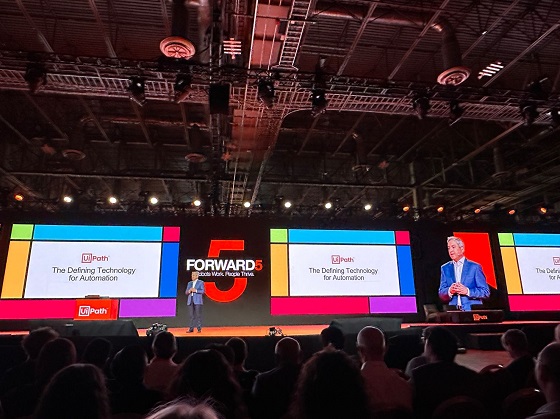Daniel Dines used this week’s Forward 5 to share some now-familiar memories of UiPath evolution—but also showcases an intriguing new type of personal automation.
“We intend to stay fast and bold and continue our evolution in a world where innovation will change completely—a world where automation is providing a new way of operating and a new way of innovation.”
This was the final message of UiPath Co-Founder and Co-CEO Forward 5 keynote Daniel Dines at this week’s annual UiPath user conference, Forward.
Dines took over an hour to get to this message to the global RPA community—taking a huge tour d’horizon that went from the very earliest days of what was then a small Bucharest start-up and is now a billion dollar revenue company to his views on technology, and live chats with key UiPath partners Microsoft and Accenture.
Much of the journey was familiar from previous Forwards, including his evident pride at his company’s success. “I want to thank you to all UiPath employees for putting on such a great event and for building such a great company,” he said. “I cannot express in words how proud and humbled I am to have been part of building such an amazing company.”
It was Dines’ reflection on the product side of UiPath and less the corporate history and partnerships that most interest lay for the non-UiPath employee or grateful customer.
A key demo was delivered, for example, by the company’s Principal Product Manager, Cosmin Voicu. This was to make a bit more real some of the company’s previously rather fuzzy talk around ‘semantic automation,’ which even Dines admitted has so far not landed that effectively (“though we spoke for a while about semantic automation, I’m not sure many people really understood what we were talking about”).
Software that models what you want to do with data
What Voicu actually showed was what seemed like very promising personal automation technology, which he claimed will be “the next big thing in automation for UiPath.”
He said, “Regular users–meaning business users, and even consumers–that are not very inclined to interrupt their workflow to fire up Studio and start working on an automation from scratch.”
Nonetheless, every user of a computer tends to have to perform repetitive form-filling, like for airline or hotel check-in, while business users are, despite every Business Intelligence vendor’s best effort, still addicted to that universal database enterprise model, Excel.
For both classes of users, semantic automation, claimed Voicu, offers a very easy way to capture and then duplicate key information and keep pasting it in the right format into the document type the user wants to work with.
“With semantic automation, all you need to do is bring up the document–in this case, it’s a passport that contains your details copied, and once this is analyzed, you can you see highlights and a preview of what data was extracted. Then, all you need to do is go to the destination—in this case, the check-in form—and hit ‘paste.’”
This is done via a semantic model of the information you want to work with being built by the software, he added, so that, “a process that normally took a few tedious moments that probably nobody wants to do gets solved with just a few a few clicks.”
The software also captures user intent, it seems. In this demo, it noticed that the user liked purple as a background color, and while it didn’t have that option in the destination screen came up with its next-best offer—violet.
Is the future of automation, then, bringing this level of semantic ‘understanding’ down into accessible automation—potentially even making working with unstructured data in business documents a lot easier?
Time will tell. But given that UiPath says it only invented the very concept of RPA with the 2017 Forward—chances look strong that Dines is on to yet another idea that might make him a two billion dollar company before too long.
See also

